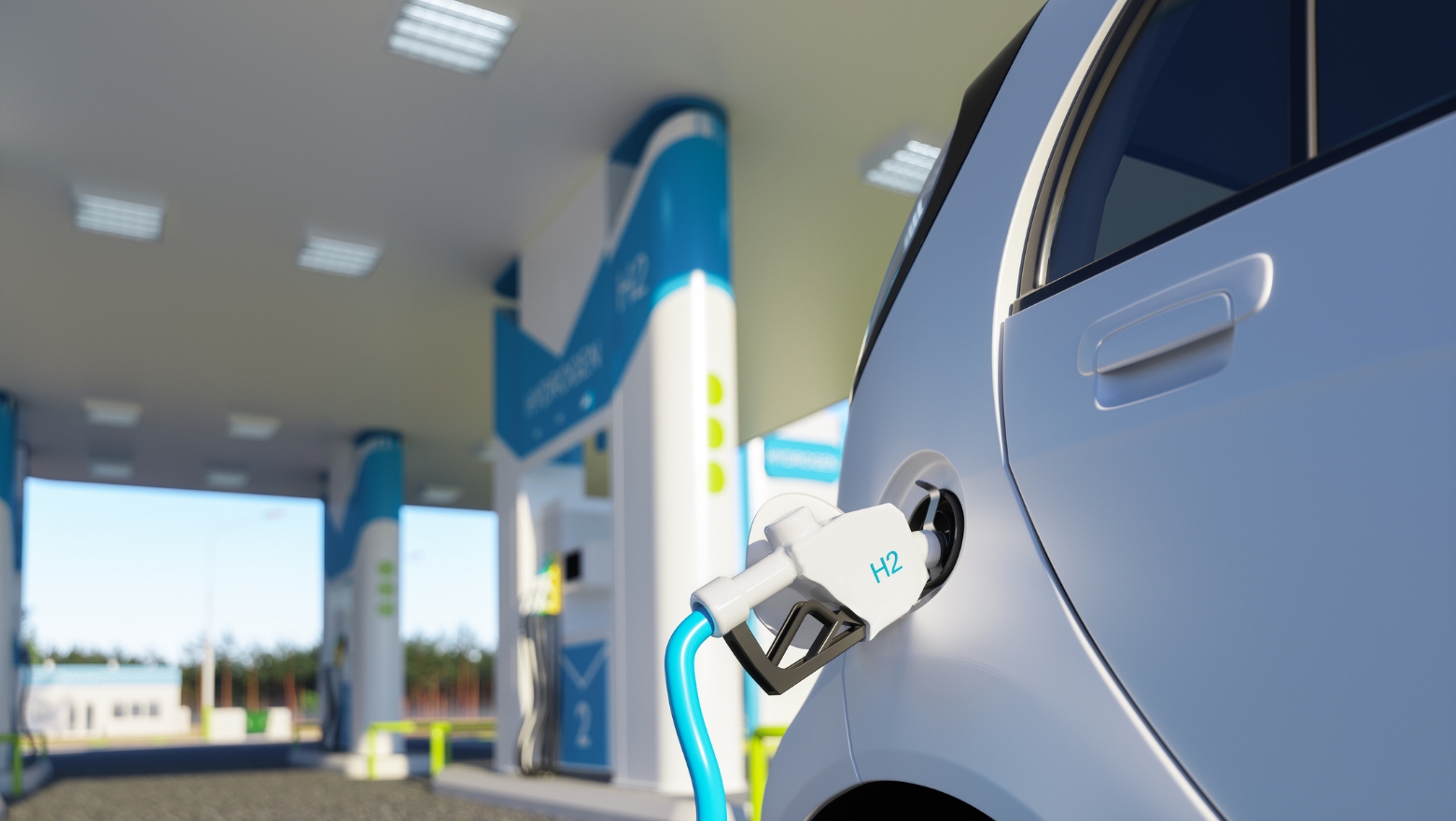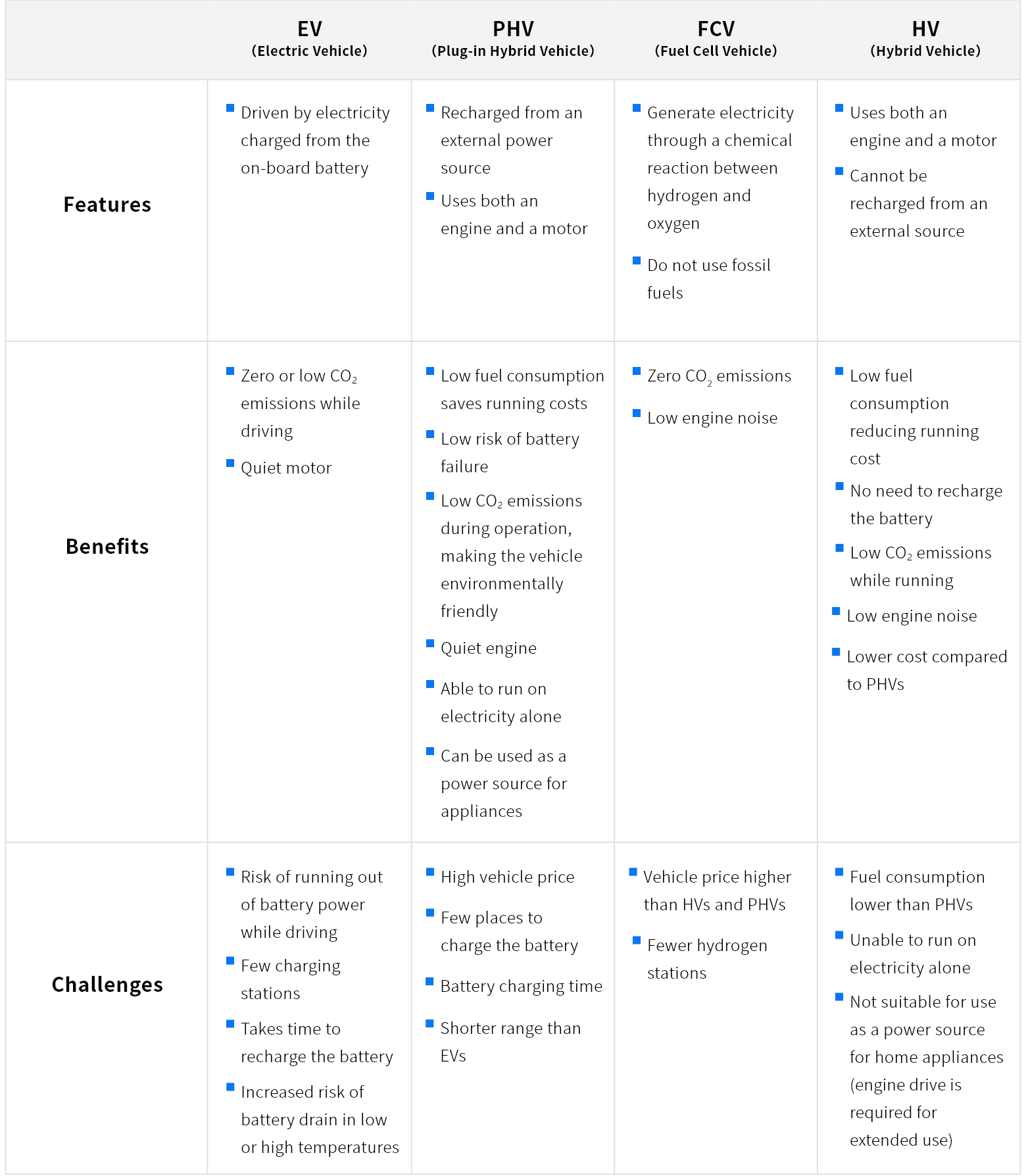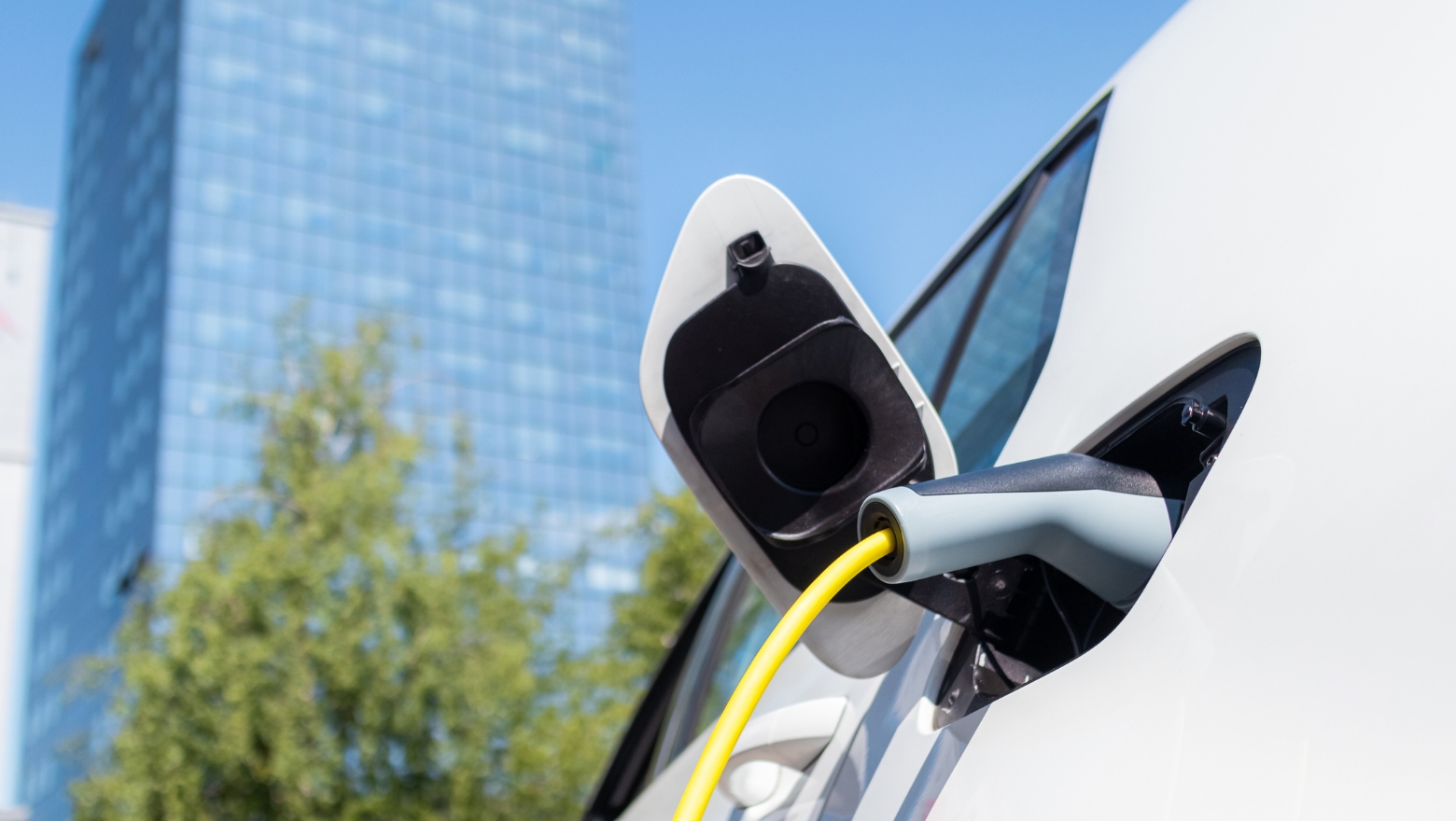
Classifications of Electric Vehicles
When people hear the term "EV," they tend to think of it as a vehicle powered solely by electricity and a motor without an engine. However, EV is a generic term for electric vehicles powered by an onboard battery, which includes Plug-in Hybrid Vehicles (PHVs), Fuel Cell Vehicles (FCVs), and Hybrid Vehicles (HVs). Electric vehicles that do not use an engine and are powered only by electricity stored in a battery and a motor are referred to as BEVs (Battery Electric Vehicles). On the other hand, vehicles that also use gasoline, diesel fuel, hydrogen, or other energy sources in addition to electricity stored in the battery are distinguished as PHVs, FCVs, or HVs.

EVs - Motors driven solely by battery power
An EV is an electric vehicle powered by an onboard battery charged from a dedicated charging spot or facility, and the motor is driven solely by electric power. They do not contain an engine or gasoline tank and are characterized by their simple configuration, requiring only a motor, wheels, and a large-capacity battery to drive the vehicle.
Advantages of EVs
Since fossil fuels do not power EVs, the motor has zero emissions during operation, creating environmentally friendly mobility for owners. In addition, the motor is quiet and generates no vibrations. Most owners have charging units at their homes, allowing for convenient charging during evening hours. Night charging can further reduce overall costs in areas with variable electricity costs.
It is important to note that EVs may contribute carbon emissions during charging, depending on how the electricity is generated. If EVs use electricity generated from renewable energy sources, emissions are eliminated during power generation and driving.
Disadvantages of EVs
The power infrastructure of charging stations is significantly lower than gasoline-powered vehicles, presenting a risk of running out of battery power when traveling long distances, especially when it is difficult to find a charging location. In addition, the cruising range of EVs is shorter than that of gasoline-powered vehicles, presenting more complications on longer trips. Another significant challenge is that charging takes longer than refueling with gasoline or diesel fuel.
HVs - Driven by two power sources—an engine and a motor
HVs use an engine and a motor to drive and do not charge the battery from an external power source like EVs, but instead from the engine or kinetic energy while driving. Low fuel consumption is achieved by using the motor to assist the engine during a startup or low-speed driving when a burden is put on the engine.
HVs are segmented into series HVs, parallel HVs, and series-parallel HVs (split HVs), depending on the power generation and drive.
Series HV: The engine is used to turn the generator, and the power drives the motor from the generator.Parallel HV: Runs on both the engine and the motor, but the engine is the primary driver. The motor assists power at a vehicle start or during acceleration when the engine consumes more fuel.Series-parallel HV (Split HV): The engine's energy is split into driving and power generation, and the engine and the motor are used separately for efficient driving. The vehicle runs on the motor alone at a start and low speed, using both the engine and the motor as the speed increases.
All three types of HVs are equipped with a battery that has a capacity large enough to run the motor alone, plus a high-output engine. Such HVs are called strong HVs (full hybrid HVs). In contrast, if an HV has a small-capacity battery or a motor incapable of running the vehicle, it is referred to as a mild HV.
Advantages of HVs
Unlike EVs, HVs do not need to be charged from an external power source, so there is no need to worry about running out of battery power. There is no need to look for a recharging spot even on long-distance drives, and the vehicle can be used the same way as a gasoline-powered vehicle. In addition, HVs can be manufactured at a lower cost than PHVs, so they offer both a low vehicle price and low fuel consumption, which is a significant advantage.
Disadvantages of HVs
Since HVs are driven by both an engine and a motor, they cannot run on electricity alone and must be refueled. Also, like PHVs, owners cannot use them to charge appliances in an emergency.
PHVs - Combining the advantages of EVs and HVs
PHVs share with HVs the use of both an engine and a motor, but the major difference is that PHVs can be charged from an external power source. In other words, PHVs combine the features of both EVs and HVs and are highly practical and environmentally friendly.
Advantages of PHVs
PHVs are more fuel-efficient than HVs and are expected to save on running costs. In addition, although they can be charged from an external power source, there is less risk of running out of battery power, as with EVs, and they can also run on electricity alone. They can also be used as a power source for home appliances and may be useful in emergencies.
Disadvantages of PHVs
Compared to HVs, PHVs are more expensive. Another disadvantage is that owners must install dedicated charging units at home, with limited charging infrastructures.
FCVs - Generating and charging electricity with hydrogen and oxygen to drive the motor
FCVs (fuel cell vehicles) do not use fossil fuels like gasoline vehicles, HVs, or PHVs, but instead convert the energy produced by the chemical reaction between hydrogen and oxygen into electricity to charge the battery.
Advantages of FCVs
FCVs do not emit CO2 emissions during operations, making them environmentally friendly. Another significant advantage is that FCVs are quiet and have almost no vibration.
Disadvantages of FCVs
Only a limited number of automakers have adopted FCVs, and vehicle prices are higher than for HVs and PHVs. In addition, there are very few hydrogen stations, and there is a risk of being unable to find a hydrogen refueling point when driving long distances.
The Importance of Material Development for Further Adoption
HVs are already widely popular among EVs, but PHVs, FCVs, and BEVs must overcome various challenges to become equally popular. For example, the challenge for BEVs and FCVs is to extend the cruising range, which requires light and strong materials to reduce the vehicle's body weight. In particular, BEVs require batteries with high electric capacity that can be stored on a single charge. These batteries are becoming larger and account for a higher percentage of the overall vehicle weight.
At the same time, there is an increasing demand for higher safety against ignitions and fires, which may occur in a vehicle collision or battery operation. The thermoplastic fiber-reinforced composite GMT eFR, developed by Mitsubishi Chemical, is a material that combines strength, rigidity, lightweight, and fire safety. This material is ideal for battery pack exteriors and other applications.
Additionally, batteries experience rapid discharge in cold climates and other locations with low temperatures. Lithium-ion batteries are required to operate stably in environments ranging from low to high temperatures to maximize EV batteries, regardless of the season or location. Using Mitsubishi Chemical's Sol-Rite, an organic solvent-based electrolyte, battery performance is greatly improved.
Mitsubishi Chemical researchers continue to develop next-generation electrode materials that enable vehicles to charge more quickly. Mitsubishi Chemical also offers MPG, a natural graphite-based anode material for lithium-ion batteries that enables rapid charging and discharging, and ICG, an artificial graphite-based material with high capacity and long life.
In addition, we are developing a polymer epoxy film that will allow the various electronic components needed for EVs to be mounted using printing technology.
To further user adoption of electric vehicles, it is increasingly important to develop materials to solve the issues faced by EVs, PHVs, FCVs, and HVs. For lithium-ion batteries, which hold the key to the further spread of electric vehicles, it is essential to reduce the environmental impact of lithium-ion batteries during their entire life cycle, from manufacturing to disposal and recycling. Mitsubishi Chemical is committed to reducing environmental impact through various material technologies, including developing materials that improve battery life to enhance the environmental performance of electric vehicles further and contribute to their commercialization and widespread use.



